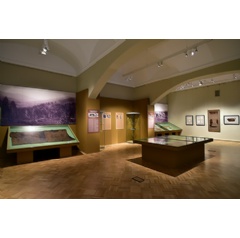Opening of the exhibition “An Archaeological Phenomenon. Between the Past and the Future”
On 26 April 2024, the exhibition ”An Archaeological Phenomenon. Between the Past and the Future” was formally opened at the State Hermitage. It is devoted to three round dates: the 160th anniversary of the birth of the traveller and explorer of Central Asia Pyotr Kuzmich Kozlov (1863–1935), the 100th anniversary of the Mongolian-Tibetan Expedition and 100th anniversary of the start of the scientific study of the archaeological site in the Noin Ula hills.
The exhibition has been organized by the State Hermitage with the participation of the Institute of Archaeology of the Mongolian Academy of Sciences, the Russian Geographical Society, the Institute for the History of Material Culture of the Russian Academy of Sciences, the Russian Ethnographic Museum, the State Archive of the Russian Federation and the Institute of Archaeology and Ethnography of the Siberian Branch of the Russian Academy of Sciences. Simultaneously with the exhibition, on the top floor of the Winter Palace the revamped hall housing the permanent display of the “Noin Ula Archaeological Site” (Hall 367) was also presented.
Opening the exhibition, Mikhail Piotrovsky, General Director of the State Hermitage, said: “We are marking a great event in the history of the study of humanity, because this is about the discovery of royal burial mounds – exceptionally rich in contents and incredibly interesting for researchers – connected with the nomadic Xiongnu people. The exhibition crowns the expedition work of Pyotr Kuzmich Kozlov, who was responsible for two great discoveries – Khara-Khoto and Noin Ula. He will always remain in our memory as one of the foremost explorers of Central Asia. And today’s generation of Hermitage staff, researchers, archaeologist and restorers, paying tribute to Pyotr Kuzmich Kozlov’s accomplishments is presenting in this exhibition an account of how the Mongolian-Tibetan Expedition came about and how it went, what unique artefacts the Noin Ula hills revealed to the world, what was done with that and how it was saved. All this became possible through productive collaboration of scholars from Russia and Mongolia.”
Also participating in the opening ceremony were Nasan-Ochir Erdene-Ochir, Academic Secretary of the Institute of Archaeology of the Mongolian Academy of Sciences, Ilya Gurov, First Deputy Executive Director of the Russian Geographical Society, Andrei Polyakov, Director of the Institute for the History of Material Culture of the Russian Academy of Sciences, and, from the Hermitage, Georgy Vilinbakhov, Deputy General Director for Research, Svetlana Adaksina, Chief Curator, Deputy General Director for Record-Keepingand Storage, Natalia Kozlova, head of the Oriental Department, Andrei Nikolayev, deputy head of the Oriental Department, and the exhibition’s curator – Natalia Sutyagina, senior researcher in the Central Asia and Caucasus Sector of the Oriental Department.
The excavations that the Mongolian-Tibetan Expedition under Pyotr Kozlov’s leadership conducted in 1924–25 in the Noin Ula hills of northern Mongolia revealed to the world rich burials of the elite of the nomadic Xiongnu people (3rd century BC – 1st century AD). The geographic location in the permafrost region, the incredible depths to which the graves were dug (over 10 metres), and the character of the ancient burial rite were favourable to the good preservation of the wooden tombs and the grave goods, especially fabrics and wooden objects. The items that had been used by the Xiongnu nomads dated back around 2,000 years. The objects found were made of various materials: silk and woollen fabric, extremely fine embroidery, felt carpets beneath the burials, little lacquer bowls, gold and silver articles, metal, wooden and ceramic vessels, parts of chariots and horse harness. Thanks to Kozlov’s talent and activities as a researcher and educator, this archaeological discovery immediately became a sensation.
The exhibition “An Archaeological Phenomenon. Between the Past and the Future” presents the most interesting finds and the results of the very latest laboratory studies. On show in the halls are unique ancient artefacts, historical documents and photographs connected with the study of the Noin Ula burials.
The exhibition, in Halls 351–353 on the top floor of the Winter Palace, can be visited by all holders of tickets to the Main Museum Complex until 29 September 2024.
( Press Release Image: https://photos.webwire.com/prmedia/6/321075/321075-1.jpg )
WebWireID321075
This news content was configured by WebWire editorial staff. Linking is permitted.
News Release Distribution and Press Release Distribution Services Provided by WebWire.
